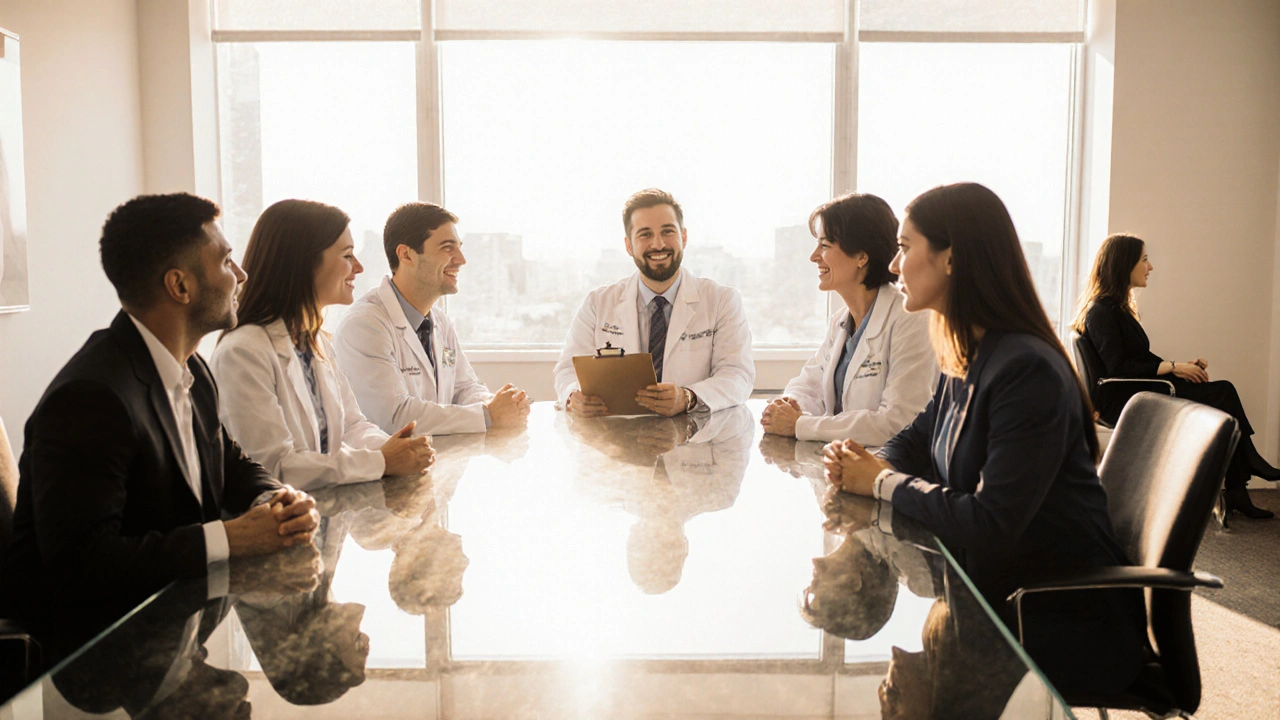Lupus Check-up Schedule Calculator
How Often Should You Schedule Your Lupus Check-up?
This tool helps you calculate your recommended follow-up schedule based on your current disease activity and pregnancy status.
Your Recommended Check-up Schedule
Select your disease activity level to see your recommended schedule.
What to Expect at Your Next Check-up
Your doctor will likely review your symptoms, check lab results, and possibly perform a physical examination. You should bring any new symptoms or concerns you've noted since your last visit.
Red Flag Symptoms
Contact your doctor immediately if you experience any of these symptoms:
- Sudden swelling of legs, ankles, or face
- New severe headache, confusion, or visual changes
- Sharp chest pain that worsens with breathing
- Blood in urine or rapid increase in proteinuria
Key Takeaways
- Both discoid and systemic lupus need lifelong monitoring to catch complications early.
- Typical follow‑up intervals range from every 3months (active disease) to annually (stable disease).
- Dermatologists, rheumatologists, and primary care doctors form the core care team.
- Blood work, urine analysis, and imaging are the most common tests during visits.
- Knowing warning signs-new rashes, joint swelling, fatigue spikes-helps you act fast.
Living with Discoid Lupus Erythematosus is a type of chronic skin‑targeted autoimmune disease that causes disc‑shaped, often scarring rashes (DLE) can feel like a constant battle. When the same immune system also attacks internal organs, you’re dealing with Systemic Lupus Erythematosus (a multisystem autoimmune disease that may involve skin, kidneys, heart, lungs, and nervous system (SLE). Both conditions share a common thread: the body’s defense mechanisms turn against itself, creating unpredictable flare‑ups and long‑term damage if left unchecked. That’s why Lupus check-ups aren’t just routine-they’re a lifeline.
What Makes Regular Check‑ups Critical?
Early detection is the gold standard in lupus care. During a routine visit, doctors can spot subtle changes-like a tiny protein leak in the urine or a slight rise in anti‑DNA antibodies-before you feel any symptoms. Catching these shifts early means you can tweak medication, add preventive therapies, or refer you to a specialist before serious organ involvement occurs.
For DLE, regular skin examinations help prevent permanent scarring and identify secondary infections. For SLE, the stakes are higher: unchecked kidney inflammation can lead to chronic kidney disease, and undetected heart inflammation may cause arrhythmias. Consistent monitoring also gives you and your care team data to understand patterns, predict flares, and personalize treatment.

Suggested Follow‑up Schedule
The exact timing depends on disease activity, organ involvement, and treatment regimen, but most clinicians follow these general guidelines:
- Active disease or new medication: every 4-6weeks for the first 3months.
- Stable disease (no flares for 6months): every 3months.
- Long‑term remission (no flares for 1+ year): every 6-12months.
- Pregnancy or planning pregnancy: monthly check‑ups with obstetrics and rheumatology.
These intervals are a roadmap, not a rule. Your doctor may adjust them based on lab results, medication side‑effects, or new symptoms.
Who Should Be In Your Care Team?
Managing lupus is a team sport. Here are the key players:
- Dermatologist - evaluates skin lesions, prescribes topical treatments, and monitors for skin cancer.
- Rheumatologist - oversees systemic disease activity, adjusts immunosuppressive meds, and coordinates organ‑specific referrals.
- Primary Care Physician - tracks overall health, vaccinations, and routine health maintenance.
- Nephrologist - consulted when kidney involvement is suspected.
- Cardiologist - monitors heart inflammation and vascular health.
- Obstetrician‑Gynecologist - vital during pregnancy planning and management.
Typical Tests Performed During Check‑ups
| Test | Purpose | Frequency (Typical) |
|---|---|---|
| Complete Blood Count (CBC) - checks for anemia, leukopenia, thrombocytopenia | Detects blood‑cell abnormalities that signal disease activity or medication side‑effects | Every visit |
| Comprehensive Metabolic Panel (CMP) - monitors liver and kidney function | Identifies organ involvement early | Every 3-6months |
| Urinalysis - looks for protein, blood, casts | Tracks kidney inflammation (lupus nephritis) | Every 3months (more often if kidney disease present) |
| Anti‑dsDNA & Complement Levels | Serologic markers that rise with flares | Every 1-2months during active disease |
| Echocardiogram (heart ultrasound) | Detects pericardial effusion or reduced function | Annually or as symptoms dictate |
| Skin Biopsy | Confirms discoid lesions and rules out skin cancer | When new or changing lesions appear |
Red‑Flag Symptoms That Need Immediate Attention
Even with regular monitoring, some signs scream “call your doctor now”:
- Sudden swelling of the legs, ankles, or face.
- New onset of severe headache, confusion, or visual changes.
- Sharp chest pain that worsens with breathing.
- Blood in the urine or a rapid increase in proteinuria.
- Persistent fever above 38°C (100.4°F) lasting more than 48hours.
- Rapidly expanding rash or ulcerated skin lesions.
These symptoms could indicate flare‑related organ damage and warrant urgent evaluation.
Preparing for Your Lupus Appointment
A quick prep checklist can make every visit smoother and more productive:
- Write down any new symptoms, even if they seem minor.
- Bring a list of all medications, supplements, and over‑the‑counter drugs.
- Note the dates of your last lab results and any changes since then.
- Prepare questions about side‑effects, lifestyle adjustments, or upcoming vaccinations.
- Carry a medication schedule or pill organizer to show adherence.
- If you’re pregnant or trying to conceive, have your last menstrual period and any prenatal labs ready.
Being organized helps your team spot trends faster and tailor treatment on the spot.
Frequently Asked Questions
How often should someone with stable discoid lupus see a dermatologist?
If the skin disease is quiescent and no new lesions appear, a dermatologist visit every 6months is usually sufficient. However, any sudden change in rash appearance should prompt an earlier appointment.
Can regular blood tests cause anemia in lupus patients?
Frequent phlebotomy can lower iron stores, especially if you’re already anemic from disease activity. Discuss with your rheumatologist about spacing out CBCs or using smaller volume tubes when possible.
Is it safe to stop medication when I feel better?
Never stop or taper lupus meds without medical guidance. Even when you feel great, the disease may still be active beneath the surface, and abrupt changes can trigger severe flares.
What lifestyle habits support lupus management?
Regular low‑impact exercise, sun protection (SPF30+ daily), balanced nutrition rich in omega‑3s, adequate sleep, and stress‑reduction techniques (mindfulness, yoga) all help keep disease activity down.
How does pregnancy affect the need for check‑ups?
Pregnancy increases monitoring frequency to monthly or even bi‑weekly visits, because hormonal changes can trigger flares and both mother and baby require close surveillance for kidney and blood‑pressure issues.



liam martin
12 October / 2025When you think about living with lupus, the ticking clock of hidden damage becomes a silent soundtrack to every morning. Regular check‑ups are the only way to turn that soundtrack into a readable score, letting doctors catch the slightest crescendo before it turns into a full‑blown flare. Skipping appointments is like ignoring a leak in a dam-you might not see water spilling out until the whole wall collapses. So set those reminders, bring your symptom journal, and treat each visit as a lifeline rather than a chore.